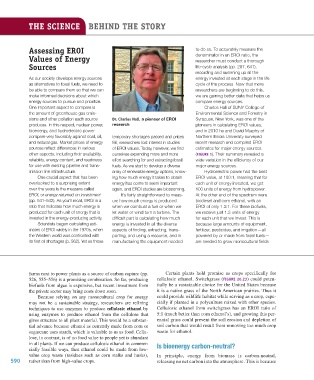Page 591 - Environment: The Science Behind the Stories
P. 591
THE SCIENCE BEHIND THE STORY
Assessing EROI to do so. To accurately measure the
Values of Energy denominator in an EROI ratio, the
researcher must conduct a thorough
Sources life-cycle analysis (pp. 287, 641),
recording and summing up all the
As our society develops energy sources energy invested at each stage in the life
as alternatives to fossil fuels, we need to cycle of the process. Now that more
be able to compare them so that we can researchers are beginning to do this,
make informed decisions about which we are gaining better data that helps us
energy sources to pursue and prioritize. compare energy sources.
One important aspect to compare is Charles Hall of SUNY College of
the amount of greenhouse gas emis- Environmental Science and Forestry in
sions and other pollution each source Dr. Charles Hall, a pioneer of EROI Syracuse, New York, was one of the
produces. In this respect, nuclear power, research pioneers in calculating EROI values,
bioenergy, and hydroelectric power and in 2010 he and David Murphy of
compare very favorably against coal, oil, temporary shortages passed and prices Northern Illinois University surveyed
and natural gas. Market prices of energy fell, researchers lost interest in studies recent research and compiled EROI
sources reflect differences in various of EROI values. Today, however, we find estimates for major energy sources
other aspects, including their availability, ourselves expending more and more (FIGURE 1). Their summary revealed a
reliability, energy content, and readiness effort searching for and extracting fossil wide variation in the efficiency of our
for use with existing pipeline and trans- fuels. As we start to develop a diverse major energy sources.
mission line infrastructure. array of renewable energy options, know- Hydroelectric power had the best
One crucial aspect that has been ing how much energy it takes to obtain EROI value, at 100:1, meaning that for
overlooked to a surprising extent energy has come to seem important each unit of energy invested, we get
over the years is the measure called again, and EROI studies are blossoming. 100 units of energy from hydropower.
EROI, or energy returned on investment It’s fairly straightforward to meas- At the other end of the spectrum were
(pp. 541–542). As you’ll recall, EROI is a ure how much energy is produced biodiesel and corn ethanol, with an
ratio that indicates how much energy is when we combust a fuel or when we EROI of only 1.3:1. For these biofuels,
produced for each unit of energy that is let water or wind turn a turbine. The we receive just 1.3 units of energy
invested in the energy-producing activity. difficult part is calculating how much for each unit that we invest. This is
Scientists began calculating esti- energy is invested in all the diverse because large amounts of equipment,
mates of EROI widely in the 1970s, when aspects of finding, extracting, trans- fertilizer, pesticides, and irrigation—all
the Western world was confronted with porting, and using a resource, and in powered by or made from fossil fuels—
its first oil shortages (p. 562). Yet as those manufacturing the equipment needed are needed to grow monocultural fields
farms next to power plants as a source of carbon capture (pp. Certain plants hold promise as crops specifically for
526, 555–556) is a promising combination. So far, producing cellulosic ethanol. Switchgrass (FIGURE 20.23) could poten-
biofuels from algae is expensive, but recent investment from tially be a sustainable choice for the United States because
the private sector may bring costs down soon. it is a native grass of the North American prairies. Thus it
Because relying on any monocultural crop for energy could provide wildlife habitat while serving as a crop, espe-
may not be a sustainable strategy, researchers are refining cially if planted in a polyculture mixed with other species.
techniques to use enzymes to produce cellulosic ethanol by Cellulosic ethanol from switchgrass has an EROI ratio of
using enzymes to produce ethanol from the cellulose that 5:1 (much better than corn ethanol’s), and growing this per-
gives structure to all plant material. This would be a substan- ennial grass could prevent the soil erosion and depletion of
tial advance because ethanol as currently made from corn or soil carbon that would result from removing too much crop
sugarcane uses starch, which is valuable to us as food. Cellu- waste for ethanol.
lose, in contrast, is of no food value to people yet is abundant
in all plants. If we can produce cellulosic ethanol in commer- Is bioenergy carbon-neutral?
cially feasible ways, then ethanol could be made from low-
value crop waste (residues such as corn stalks and husks), In principle, energy from biomass is carbon-neutral,
590 rather than from high-value crops. releasing no net carbon into the atmosphere. This is because
M20_WITH7428_05_SE_C20.indd 590 13/12/14 1:56 PM

